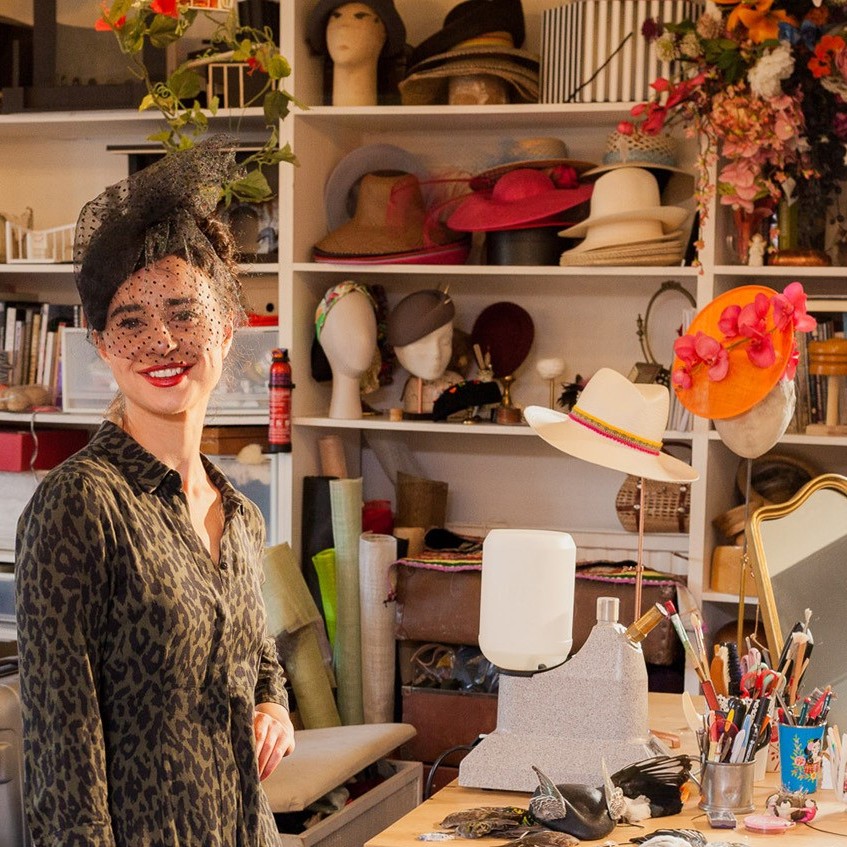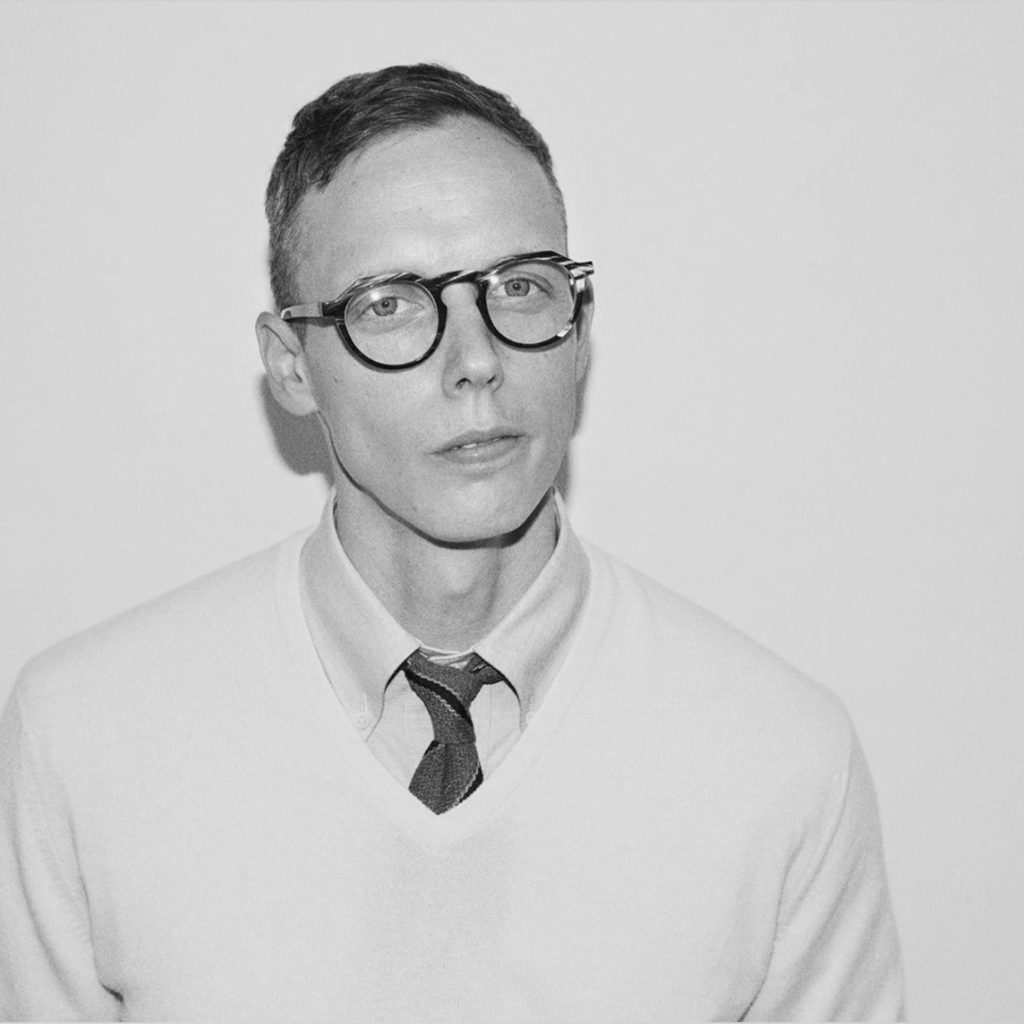Patrick Ahern Crochet Artist - Woodland Hills, CA, USA
How did you break down this major misconception about who does crochet?
I never thought crochet was something I could not do because it wasn’t what men were supposed to do. When I first started crocheting, I did it to impress a girl – so I wasn’t thinking at all! The only thing I knew to make were clothes and accessories – which was harder for men to understand than women. Luckily, I was bad at sizing and I only used unwearable wool so I did other things with crochet. But I do feel it is more accepted for me to crochet art rather than scarves.
Do you see your art as breaking gender barriers?
My artwork is very much a craft to me and craft has no gender barriers. It is exciting to see crochet accepted as a powerful medium. It can make complex mathematical models and an afghan. But I do hope to inspire other men and boys to start crocheting because I think everyone should learn how. My artwork seems so far removed from popular crochet that I think the tapestry is seen more as a finished piece without really thinking of it as crochet.
When did you decide that crochet would be your art medium?
I wasn’t good at making wearables. My favorite fiber is wool, which does not work well with most people who are used to soft, machine washable materials. The only art I made was music, so I only made art with crochet when I was looking for something different to do with it.
As well as crocheting you are a musician. Can you expand on how the two relate?
They both involve numbers and patterns. In crochet there is your foundation row, and in music there is your time signature. I then use patterns and improvisation based on those restrictions to make art and to make music. Crochet lends itself very well to freeform, like music, since it is not restricted to a grid like weaving of knitting. Crocheting and music also go very well together!
How did your mum come to teach you how to crochet?
Very patiently – I asked her if she could show me how to crochet a small bag. Whenever I teach someone how to crochet, I think of that time and I remember that it was very hard for me to see what I was doing. She taught me to focus on my work and pay attention to the stitches. Eventually, you begin to see the stiches and how they work and then you can make anything.
Your mum still helps you by creating the backings for your work. Can you expand on this?
Sarah Crow is a fascinating woman. She designed the backings for all of my pieces. She knows her way around a sewing machine and serger much better than I ever will, so I don’t even try to do what she does. She lives back east now, so I sporadically get her dimensions, she whips one up in a few, and ships it out. It is a very efficient collaboration.
You have done a portrait of your mum,can you discuss this work?
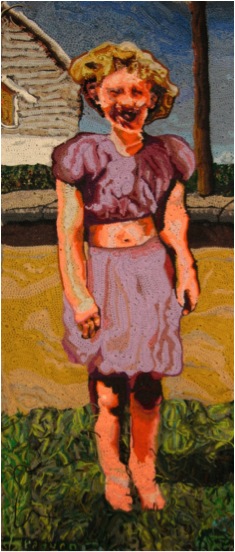
My mom looks exactly the same today as in that image taken around 1950. She has the same face and even my nieces look like her now. It is a dedication to her spirit. I reckon it was taken somewhere in Napa, CA – where she grew up. The photo I used was her holding hands with an unknown girl. I took the girl out of it and changed the background to have a new-suburb feel. I like the grass because it’s crocheted with the ends left out.
Can you discuss ‘Chloe Dancer?’
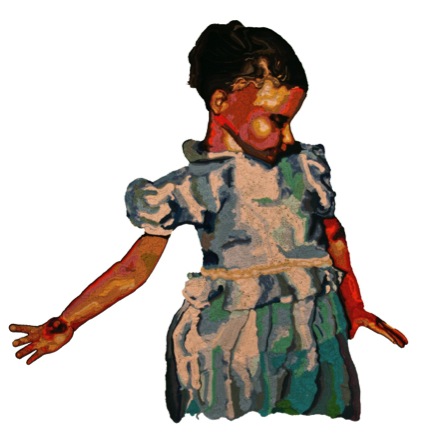
This was inspired by my sister, Chloe. I had a photograph when she was young in this interesting pose. I think she was grabbing or setting down a drinking glass, so that is why her right hand is open. It looked like she was dancing or spinning, so that’s what I went with. I named it Chloe Dancer after the Mother Love Bone song. She is also a huge Pearl Jam fan, so it was fitting since Mother Love Bone became Pearl Jam – it was an inside joke.
What brought you to transfer the art of 2D tapestry to crochet?
After being discouraged with my hats and things I didn’t know what to do. I always liked to crochet so I was looking for other things to make. I had a picture of Clara Bow so I decided to try to crochet it. I had other ideas in my head for images, so I just crocheted them.
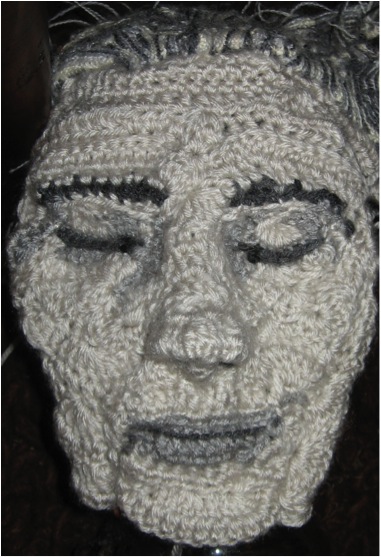
As with a tapestry, do you work with a cartoon?
I work with photographs and drawings. I take parts here and there, and arrange them into a final image. I use the image as a guide for proportion and color.
Why is tapestry yarn so suitable to your work?
Tapestry yarn is typically wool and it comes in small yardage – so they are much like paint tubes! My stuff involves a lot of yarn changes, which means a lot of snipping of yarn. I don’t work well with multiple skeins at a time because it all ends up in a big knot.
How do you create the ‘right’ colours?
I love bright colors, but most of the time I am looking at value. It does not matter which color goes where, as long as the shadow and light look right to the viewer. Yarn comes in so many colors and variations that I just try different thing and even combinations of yarn until it works for the image.
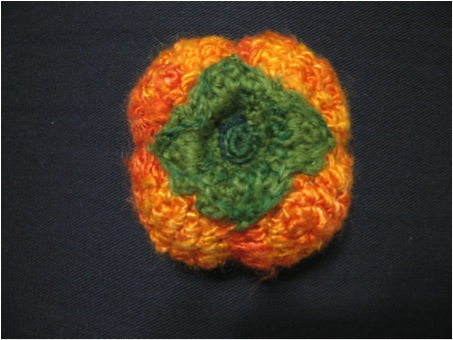
In the ‘Orange Papa’ you combine wool and acrylic yarn. Do they have substantial differences?
Yes they do. I also use different weights of yarn so my tapestries can undulate too much if I am not careful. What I like about wool is its rich color and it is much easier to break than acrylic when I need to change the yarn! Most of the acrylics I use have more sheen to them than wool, so it makes for interesting effects.

Can you discuss ‘Yarn’?

Inspiration
This was an image I had in mind for a long time. The image is me, taking a break from writing – lost in a daydream. It’s usually when I snap out of it that I realize that I haven’t got any work done!
Technique
I made this one quickly – in about a month. I used my photograph as a reference and made the book and pen later. I made one other face before that I scrapped because it looked nothing like me. There is a lot of thick wool tapestry yarn in there for the yellow background.
Use of colour
I used very bright oranges, yellows, & greens for this one. It is a lot brighter than it appears in images – almost like a blacklight poster. One of the reasons I tossed the first face I made was because there were little changes in the oranges of the face, so it looked washed out.
Discuss how you are now developing 3D in your work?
I have been crocheting many fruits and vegetables. It’s a good break from the tapestries since they are involved and time consuming. If I can feel challenged in making something in 3-dimensions I become a better artist. I still want to make more 3D faces, fruits and vegetables, and toys but I have my hands full a lot of the time!

Contact details.
Website:www.patahernart.com
Email:www.padurn@gmail.com
Patrick Ahern, Woodland Hills, CA, USA
Interview by Deborah Blakeley, March, 2014
Think a colleague or friend could benefit from this interview?
Knowledge is one of the biggest assets in any business. So why not forward this on to your friends and colleagues so they too can start taking advantage of the insightful information the artist has given?
Other artists you may be interested in:



